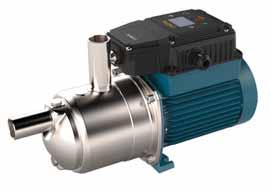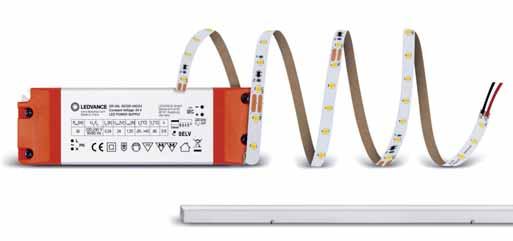
8 minute read
Renovation lighting
LIGHTING
Advertisement
LightingEurope has issued a statement strongly supporting the call in the EU Renovation Wave Initiative just published to scale up renovation rates across the European Union.
“We can only agree with VicePresident Timmermans that we need everyone in Europe to have a home they can light, heat, or cool without breaking the bank or breaking the planet,” said Ourania Georgoutsakou, Secretary General of LightingEurope (below). “However, we regret that there is no clear reference to lighting in the main RW Communication just published by the Commission, in light
of the benefits lighting can deliver not only in terms of energy savings but also in creating both safe and quality indoor environments.”
In support of this statement Georgoutsakou made these points: •Europe’s lighting industry already has the innovative and energy efficient technologies to hand, ready to install; •Properly-designed and wellcoordinated lighting systems are one of the most cost-efficient ways to reduce energy consumption and CO2 emissions. The European Commission estimates that LED-based lighting systems could save the EU up to 48-46
TWh of electricity annually by 2050; •Better indoor lighting is also one of the major factors impacting people’s wellbeing. For example, students in a classroom with bright white lights score 14% higher than students working in a poorly- -lit one; •UV-C is an established working technology for disinfection that must be part of the design of safe healthy indoor spaces. This technology has been proven to inactivate, without exception, all bacteria and viruses against which it has been tested. It is widely used today to disinfect water, air, and surfaces in industrial, commercial, medical, public and residential environments.
Georgoutsakou maintains there cannot, and should not, be any renovation of buildings in Europe without upgrading the lighting installations. To grasp the full benefits of better lighting as part of the EU Renovation Wave, LightingEurope recommend in particular: • The use of LED lighting, in combination with controls and sensors; •A full renovation of luminaires that include controls and sensors, with a minimum Smart Readiness Indicator (SRI) level. The SRI should also be applied across Europe to maximise its potential for energy savings and a better indoor environment; •The design of safe indoor spaces that includes the installation of UV-C disinfection technologies, as a means not only to address the current
COVID-19 pandemic, but also more generally and in the longer term , to help ensure healthy indoor environments; •The introduction of mandatory minimum requirements on Indoor
Environment Quality (IEQ); •Access to public financing should be subject to the fulfilment of certain conditions. An obligation to include lighting renovation to obtain full subsidy should be introduced.
See www.lightingeurope.org
LIGHTING PROJECT PROFILE

Dublin City University O’Reilly Library.
Practicalities of LED retrofi tting DCU project excellent exemplar



While the theory and rationale behind LED retrofitting is well- established and much-debated, there is far less information published on the practicalities of carrying out such projects. To redress this imbalance, Building Services Engineering recently spoke with Stephen Weir, Electrical Services Director, McKeon Group, to discuss the many LED retrofitting projects he has managed.
To begin, what is LED retrofitting?
In its simplest format it is the replacement of older, generally fluorescent type lamps and luminaires of which there are still a significant number in operation, especially in education and commercial buildings. While there is an ongoing effort to address the situation, it amazes me how many buildings are still running non LED type luminaires. What’s even more disturbing is that these luminaires continue to be maintained rather than the big picture view being taken and a decision being made to replace them with newer, more efficient fittings. This is despite considerable incentives to do so.
For instance, the SEAI Better Energy
Stephen Weir, MCIBSE IEng, Electrical Services Director, McKeon Group.

Grant Scheme includes commercial properties under its lighting-related grant aid programme. This is a pioneering approach as similar grants in the UK are only available for domestic type projects. Indeed, it is commercial properties where LED retrofitting is most beneficial and, as a global view, where energy savings can be optimised by their installation. the long-term benefits of replacing the lighting systems in their building(s). Dublin City University is an excellent example of such a client and our experience of retrofitting the lighting in the multistorey carpark, O’Reilly Library, Sports Centre and Lonsdale buildings with almost 10,000 LED luminaires were highly successful.
Having a comprehensive and accurate site survey of existing luminaires is also vital and the critical starting point in the design process. It is essential to understand what type of luminaire is required to replace the existing unit, whether it is a suspended, downlight, modular or other type of luminaire. This ensures that the contractor undertaking the project has a clearly-defined list of all luminaires to be replaced, and what they are to be replaced with. Getting this wrong can have major consequences for the project outcome, both practically and financially.
M&V (measurement and verification) is essential. An M&V study must be completed on the building’s baseline loads, along with lighting loads, to ensure there are verified primary energy savings as confirmation to the retrofitting process. This allows for post-completion analysis on what the genuine savings are, rather than just tabulated data.
What are the funding challenges?
As with any funding, the SEAI grant scheme does have its limitations in and around a set number of parameters which must be complied with. All luminaires to be installed must be on the Triple E Register and, although it should not prove to be, this is possibly one of the more difficult parts of the process. For me, luminaire selection for such projects must focus on product quality. I expect them to have a minimum 5-year warranty, optimised L&B ratings and to offer value-for-money cost wise.
However, the real issue lies in that every single luminaire and variant of each must be defined on the Triple E Register with its own individual LIG code. This can pose problems for manufacturers and consequently that product’s selection. While the luminaire may have excellent L&B ratings, be of high quality and meet budget criteria, that particular luminaire may not yet be on the Triple E Register because manufacturers upgrade their fittings on a very regular basis. I can understand the manufacturers frustration on this matter, and thankfully we have worked very successfully in this instance with Ledvance, Tamlite and a number of other manufacturers.
Nonetheless, and understanding that inclusion on the Triple E Register is part of the selection process for grant approval for public procurement projects, it is a matter that needs to be addressed. Perhaps this is an issue that manufacturers and the SEAI could collaborate on to resolve the problems associated with it.
What other challenges arise?
Regarding the actual installation, there are a number of issues that arise. In the main they tend to be in and around either the condition of the existing cabling infrastructure or indeed emergency lighting which does not fall under the SEAI grant scheme. This is a key consideration to the success of any lighting project as we, as the contractors, are responsible for certifying our element of installation to an existing cable infrastructure.
While most emergency lighting installations are now designed with stand-alone luminaires rather than combined, this is still an opportunity for the client to upgrade the emergency lighting system also. Understandably, this is also budget-dependant as it cannot form part of the grant application.
Controls are another opportunity where there can be further development within these projects. Often there is little to no localised control or simply a contactor arrangement allowing “master off ”of all luminaires at the end of the night within the existing control system. Allowing for daylight dimming and absence detection will not only provide for an optimised energy reduction, but will also add to the comfort and safety of those using the building.
Having now retrofitted over 12,000 luminaires through a multitude of projects, I have come across many of the practicalities as discussed above. It still excites me to see not only the final energy reduction through verified M&V, but also the delight end-users

experience on the upgrading of luminaires and lighting quality. However, an additional unseen issue in many instances is that the new lighting quite often highlights the need to replace carpet, or to re-paint parts, if not all, of the building.
What can the client expect?
There are numerous factors that influence what energy reduction a client can expect, such as building occupancy, controls type and existing luminaire type whether it be T8 or T5 type lamps. One of the most successful I have experienced is the Dublin City University multi-storey car park where we utilised individual sensors built into each luminaire. Centre driving line luminaires are programmed to be on at 20% at all times, and to then illuminate to 100% when a car or person passes under them. Luminaires over each parking bay only switch on in the event of a car or person being under them. The preexisting fluorescent T8 luminaires, along with minimal existing control, meant that year-on-year energy usage was reduced by 421,794kWh. This was a huge success for the campus and indeed all involved in the project.
What future funding models to you foresee?
It will be interesting to see over the coming years if the current grants will still be available, or if more performance- type contracts are to be implemented whereby finance is offered by the supplier. Most important either way is that the quality of the luminaire remains a prime requirement. I have seen far too many LED luminaires installed that were of poor quality and efficiency, albeit not under the Better Energy grant scheme but more likely under a different level of contract.
Also, are we coming to the end of the LED lighting revolution phase? It is now time to seek out newer technologies such as POE lighting and higherefficiency LED lighting. Whatever the answer is I look forward to investigating and implementing these technologies as they come about, and being able to offer them to our clients.










